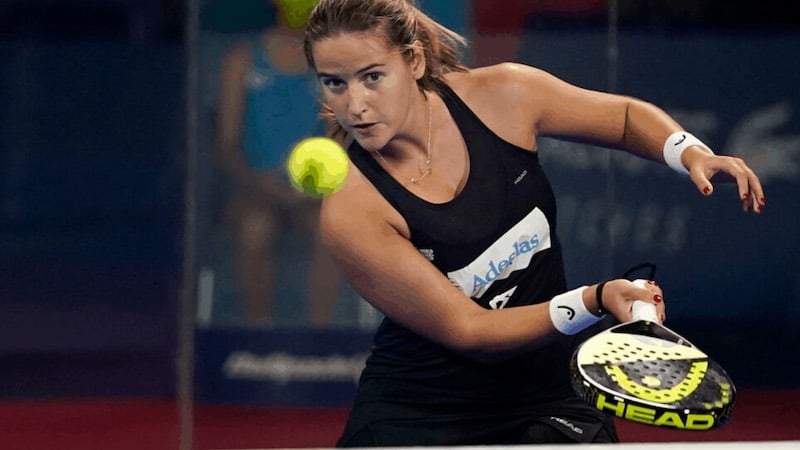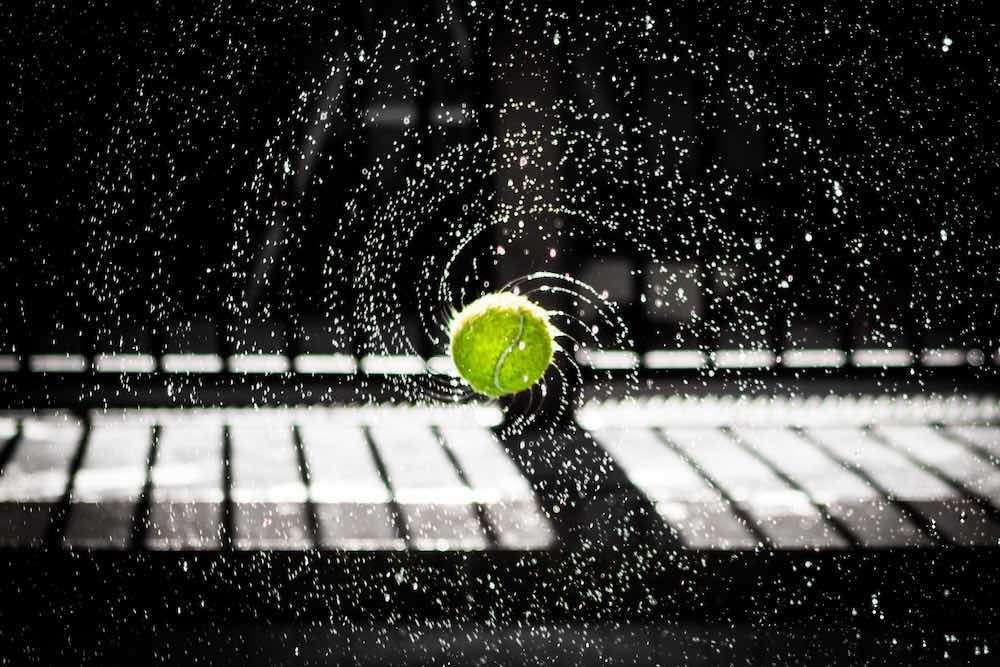Padel is a sport that allows for more creativity because you can utilize the back wall and bouncing to get into position and score points. This works thanks to a Padel slice or spin.
Advanced players who play Padel competitively can use their feet, racket position, and fore or backhand swing to spin the ball over the net and around the court.
Let’s look at the best ways to achieve a spin effect during a Padel game. We’ll look at how to spin a ball coming to you without too much difficulty. We’ll see how the net position and ball speed affect which shot to use.
Why you should use a spin when playing Padel Tennis
Advanced players can generate much speed while keeping the ball on their point of aim because they know how to use a spin. This is what keeps the ball traveling straight and free.
Spins are important on the Padel tennis court because they let you immediately dictate where you want your ball to go.
Spins make the game more exciting because only you will know where your ball is heading. You can maintain control of the court, and the ball only bounces when needed.
Spins are also useful because they create unconventional arcs and angles. The ball travels in odd ways, making it difficult for your competition to aim, slice, or respond to your serve.
Considerations when using a spin
You need to use a different slice or shot depending on the factors listed below.
These will determine what Padel spin you get, where your shot is going, your leg position, and how the balls bounce off the wall.
Recommended reading:
The Different Shots of Padel explained, a complete guide
Playing level
Some Padel spins are close to impossible to execute for beginners.
You will need high intermediate to advanced skills to nail the spin every time, but every Padel player can learn the fundamentals of creating the spin.
While you may not master the spin of your ball immediately, it is possible to try out different spins while you practice or experiment during friendly games
Points situation
Points, in this case, involve hitting with ground strokes from different points on the court.
One reason to spin your Padel ball is if you’re at the back of the court and your opponent is at the net. You can get your shot in the opponent’s middle and back wall by adding a spin.
Padel spins change depending on where you are on the court. You must choose the right shot to achieve the best spin, given your surrounding area and your opponent’s side.
Characteristics of the ball
The height of the ball from the ground and speed affect how well your Padel serve, and spinning can go.
For example, slice shots work best when the ball is above the chest and near head height, as you would like the ball to stay as close to the body as possible to avoid flying out of the court.
As for a Padel ball moving from your chest to knee level, you will need to hit it with a flat shot. This prevents excessive spinning from messing up your shot. Hitting with a flat allows you to gain control of the ball.
If your goal is to keep your shot low, only just reaching above the net, you will need to perform a topspin to hit your target and curve it to where you need it to go.
The different types of spin shots in Padel

You will need every advantage, every trick, and tool in your arsenal to win a Padel tennis game. This means knowing the different shots, how to execute them, and when to use them.
Let’s go through each of the Padel shots and the effects they create on your ball.
We’ll review their pros and cons and which works best depending on your situation on the court.
Ground shots
Ground strokes are the basis of shots made in Padel and are divided into forehand and backhand strokes. They allow you to serve, attack, defend, and fill almost every Padel role.
When working with your primary movement, the forehand stroke, your legs should start perpendicular to your opponent, with your right leg back and your left leg in front.
You will then move to a pivoting leg position as you drive your Padel racket forward, using your hips to create more force for your shoulders and arms.
Pros
Cons
- Beginners don’t realize how to turn these swings into spins in Padel
The lob
The lob can be the difference between a win and a loss in Padel. Nailing the ball with this move will allow you to compel your opponent to the wall and push forward as each stroke hits.
You can perform a J-shaped swing from below, going upward towards the other side of the Padel court, landing where it can’t be returned.
Pros
- Creates the spins that flats and topspins do
Cons
- Often done when a player is off-balance
Slice shots
The slice is a shot that allows users to send the ball across the court at such a rapid pace that their opponents won’t have time to counteract it.
Slices are not meant to be used during the serve but are best utilized during exchanges, allowing you to defend well and even turn the tide during your Padel game.
This type of shot is used in both Padel and Tennis, but it differs between sports. For Padel, slices are aggressive shots meant to win points. It is used closer to the net.
The two slice shots to know are when you need to perform a brush movement right underneath the ball to send it just over the net, and the second slice involves generating speed and power.
Pros
- Works at fast and slow speeds, high and low heights (versatile)
Cons
- Difficult to do a drop-shot when the ball is too high
The flat shot
The flat is the simplest hit to perform, as you can do it with both forehand and backhand strokes.
It provides the best control for your Padel ball and is useful during the serve and the exchange.
The flatshot creates a spin that leads to a reverse-U arc for your ball, allowing you to go above the net yet land close enough to it that your opponent won’t know how to reach it.
You must use the flat when the ball comes towards you from a low position. It allows you to send the Padel ball back before it hits the ground. It allows you to connect lobs and generate all the necessary spins.
Pros
- Can fill and fulfill all the major stroke roles (multipurpose)
Cons
- May touch the net posts if you are not coordinated or careful
- Easy to counter
The topspin shot
Overview on when to play, how to play it, how to be positioned, weigh in that this is normally used by tennis players, as in Padel backspin or slice is more common.
The topspin may be most commonly used by former Tennis players who transitioned to this sport, but they can use it wrong in this sport because you’re not supposed to jump when you serve or defend.
Like lobbing, players search for an opportunity to let the ball come to them. As it does, they commit to hitting it upward, generating speed and a narrow arc that makes it land at the opponent’s feet.
In Padel, you use the top spin when you want the ball to stay low and closer to the net. It forces your opponents where they don’t want to be, and you aim high to go low, adding to the confusion.
Pros
- High rebound, good bounce (also a possible con)
- Fast ball with possibly an unpredictable bounce
Cons
- The learning curve for tennis players used to their version of the topspin
- Could bounce too high and too far giving your opponents an easy shot at net
The backspin
The backspin comes into play when we have enough room from the back wall to serve and swing.
The goal is to hit just below the ball, making it spin opposite of how it would normally.
This is useful during a volley or intercepting a Padel serve. It can be executed when you perform a Padel-specific bandeja (back-court defense) or a vibora (front-court attack).
It is best to use the backspin in Padel when you want your opponent to have no chance to continue the ball, as the ball will be low. If it hits the back wall, the bounce will be even lower.
Pros
- Deals more damage to your opponents, no chance to rise again
- Most common spin to do
- Low bounce of the back glass
Cons
- Slower-moving ball
- Hard to master the perfect slice / back spin
The side spin
The sidespin serve is a play that messes with the opponent’s head.
It sends the ball where only you expect it to go, bouncing off the wall during a valley and giving your competitor a very hard time.
You can serve with sidespin in Padel to give you a sidewards trajectory. The ball does not travel in a linear path. Instead, it travels opposite where you strike it (if you hit with a left-side spin, the ball will go right).
It’s important to avoid the posts on the Padel net when performing this move.
When done right, the sidespin can create unique angles and tell the people on the other side to go one way as you send the ball to the other.
When used in play, the side spin is useful to avoid the need for a defensive volley because you’re minimizing the chances that your opponent can head in the right direction on time.
Pros
- It keeps your competition guessing
- You can use the side walls to kill the ball
Cons
- Easy for beginners to mess up and land the ball on their side
In Summary
Each Padel playing style is different, but whatever style you choose, a point of contact or position creates a spin that gives you better control over the court and gets you ahead of your opponent.
How the ball bounces off the paddle affects whether you have a slice shot or a topspin.
You must choose the right position to help you get over the net and power through to earn that elusive point.
Frequently asked questions about spin in Padel
All those who play Padel look for an advantage over their opponents. The best way to do this is to use the right effects, such as spins, during your attack, serve and rebound.
Let’s answer a few more questions about making the best spin shot during a Padel game:
A well-constructed and rough-surfaced Padel racket should help you achieve the right speed, spin, and paddle shots you want to make. An older racket can ruin your playing style because it’s less responsive to the ball. The best Padel rackets for beginners will help you overcome this and let you easily approach shots and spins.
It is possible to spin the ball (and you should) during a Padel game. This allows you to create difficult ball angles for your opponents and improve your attack options. You create more power during your serve.
Top spins are done in Padel when the ball is in front of you when shots are low but easy to pass back. You should strike with the top spin if you want your hits to dip past the net. Generally though, playing with slice is the preferred way in Padel.
The best way to maximize spin is to hit the ball forward right as it’s coming towards you. You should use the widest part of the racket face and not the sweet spot. Having the widest surface area helps you avoid the wall and keep your opponent guessing.
The flat shot is the most common Padel spin because it’s easier to make the ball bounce with the most contact. Aiming your ball and generating enough force to lob it forward is easy. Playing with slice is also common.
Slower-moving Padel balls that are consistent and have a bit of weight will produce more spin when you strike them. The best Padel balls will maintain their spin until the moment they bounce off the ground.

Lucas Sánchez is the founder of SimplePadel. Born and raised in Spain, Lucas has been living in the US and UK for the last 20 years and currently calls Miami his home. While he’s never played professionally, the dream is still alive.
Lucas loves nothing more than playing (and talking) about padel, and he considers himself lucky to have a wife and family that share his love for the game.

23 replies on “Padel Shot Effects: How to play with spin”
[…] mistakes committed by newbies are adding too much spin and trick-serving. This, in turn, results in service errors and inaccurate […]
[…] can use a drop shot or add a spin on your second serve to make it extra difficult for your opponent to […]
[…] provides excellent power transfer and gives you plenty of spin. It is suitable for all types of strokes including forehand, backhand and […]
[…] from 100% carbon fiber, that padel racket gives you the power you need to try those spin shots, but you don’t lose any control over the ball either with this extra […]
[…] This wide array of padel balls has padel enthusiasts scratching their heads. Which padel balls should they choose? Which balls are the best if you play with a lot of spin? […]
[…] grip. It gives you more control when hitting the ball and even allows you to hit low balls and spin balls more […]
[…] have enough room to push the balls where you want them to go. You can generate more spin or increase the force and velocity […]
[…] Padel Shot Effects: How to Play with Spin […]
[…] Comfortable racket – With excellent spin control. […]
[…] Padel Shot Effects: How to Play with Spin […]
[…] Holes Curve System that provides greater ease in handling your spins and facilitates the effectiveness of your shots in a controlled […]
[…] Technology provides the characteristic roughness of the Adidas Adipower 3.1 padel racket to achieve greater spin and […]
[…] Pack a more penetrating punch thanks to a rough finish on the bat’s surface, giving you more spin effect. […]
[…] AVS lateral anti-vibration system helps facilitate shots and achieve a great spin because of its rough […]
[…] This racket weighs 365g and has two available sleek designs and looks. The Carbon Fiber Face and textured surface supports players in getting power and spin into their shots. […]
[…] and EVA hitting surface materials allow the racket to make contact with the ball more frequently, improving your spinning and serving […]
[…] Strategic hole placements at the hitting surface for an easy swing with efficient spin in every shot […]
[…] textured surface provides an excellent light power-enhanced spin from its spin-effect […]
[…] for offensive players because it has a stock rough surface that grips the ball well, providing better ball spin and allowing players to release more power in every […]
[…] Rough silica sand finish on the face to make spin shots easy […]
[…] It also has oversized grip technology for a longer and easy-to-handle grip size. However, its rough surface can produce less bounce for your ball. Nevertheless, it still creates more spin. […]
[…] The lateral anti-vibration system in this racket gives off a rough finish so players can give the ball more spin, particularly backspin shots. […]
[…] Forgiving padel racket – has a spin-friendly design. […]